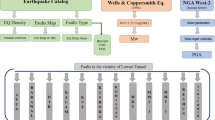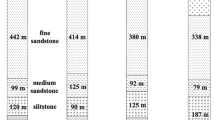Abstract
The moderate-strong (M ≥ 5, since 1976; or M ≥ 6.5, overall) earthquakes of the north to south trending (NS-trending) faults and their vicinity in the southern Qinghai–Tibet Plateau exhibit prominent spatial concentration distribution characteristics. However, research on the southern Tibet faults is limited. Hence, this study used a two-dimensional viscoelastic finite element model to simulate crustal movement in southern Tibet based on 1991–2015 GPS velocity data. The current deformation field, tectonic stress field, fault slip, and stress accumulation rates distribution were obtained to analyze the relationship between fault activity and earthquake distribution. The results revealed that the simultaneous effected by of the NE-trending compression and uneven EW-trending tension on the study area. Crustal deformation exhibited simultaneous NS-trending compression and EW-trending stretching. The EW- and NWW-trending faults and the NS-trending faults differed in their mechanical properties and movement modes. The NS faults were primarily subjected to extensional stress with normal motion. The remarkable heterogeneity of the fault segments influenced the distribution of moderate-strong earthquakes and types of earthquake ruptures. The concentrated distribution of moderate-strong earthquakes on the NS-trending normal fault and its vicinity depended largely on the high slip rate, strong tensile stress, and geometric strike of the fault segment. This study aids in understanding the heterogeneity in normal fault activity in southern Tibet and is the basis for seismic hazard assessment.






Similar content being viewed by others
Data availability
The data underlying this article are available in the article and in its online supplementary material.
Abbreviations
- GPS:
-
Global Navigation Satellite System
References
Armijo R, Tapponnier P, Mercier JL, Han TL (1986) Quaternary extension in southern Tibet: Field observations and tectonic implications. J Geophys Res 91(B14):13803–13872. https://doi.org/10.1029/JB091iB14p13803
Armijo R, Tapponnier P, Han T (1989) Late Cenozoic right-lateral strike-slip faulting in southern Tibet. J Geophy Res Solid Earth 94(B3):2787–2838. https://doi.org/10.1029/JB094iB03p02787
Bao J (2012) Numerical simulation study on the present stress-deformation mechanisms of the crustal rock mass of “Lhasa-Linzhi Block”. Dissertation, Chengdu University of Technlogy
Cao JL, Shi YL, Zhang H, Wang H (2009) Numerical simulation of GPS observed clockwise rotation around the eastern Himalayan syntax in the Tibetan Plateau. Chin Sci Bull 54(2):224–234. https://doi.org/10.1007/s11434-008-0588-7
Chen Q, Freymueller Z, Yang C, Xu W, Wang Jiang Q, Liu J (2004) Spatially variable extension in southern Tibet based on GPS measurements[J]. J Geophys Res Solid Earth 109(B9). https://doi.org/10.1029/2002JB002350
Cui ZZ, Yin ZX, Gao EY, Lu DY, Fu WZ (1990) The structure and tectonics of the crust and their relation with earthquakes in the Qinghai-Xizang plateau. Bull Chin Acad Geol Sci 2:215–226
Deng QD (2007) Map of Active Tectonics in China (1:4000000). Seismological Press, Beijing
Elliott JR, Walters RJ, England PC, Jackson JA, Li Z, Parsons B (2010) Extension on the Tibetan Plateau: recent normal faulting measured by InSAR and body wave seismology. Geophys J Int 183(2):503–535. https://doi.org/10.1111/j.1365-246X.2010.04754.x
England P, McKenzie DP (2010) A thin viscous sheet model for continental deformation. Geophys J Roy Astron Soc 73(2):523–532. https://doi.org/10.1111/j.1365-246X.1982.tb04969.x
Gan WJ (2007) Present-day crustal motion within the Tibetan Plateau inferred from GPS measurements. J Geophys Res Solid Earth 112(B8):B08416. https://doi.org/10.1029/2005JB004120
Ha GH (2019) Normal Faulting of Central-Southern Yadong-Gulu rift Since Late Cenozoic, Southern Tibet. Dissertation, China geological survery
Han TL (1987) Active tectonics of Tibet. Geological Publishing House, Beijing, pp 56–61
Ismail-Zadeh A, Le Mou lJ, Soloviev A, Tapponnier P, Vorovieva I (2007) Numerical modeling of crustal block-and-fault dynamics, earthquakes and slip rates in the Tibet-Himalayan region. Earth Planet Sci Lett 258(3–4):465–485. https://doi.org/10.1016/j.epsl.2007.04.006
Jiang FY, Zhang X, Zhang XL, Wang SX, Geng XM (2009) Research on horizontal crust movement in Qinghai-Tibet block with 2d finite element method. J Seismol Res 32(3):283–288
Kali E, Van d. WJ, Leloup PH, Mahéo G, O. Arnaud N, Liu ZJ, Chevalier M, Robin L, Tapponnier P, Thuizat R (2010) Extension in Central-South Tibet, insight from cosmogenic nuclide dating. Paper presented at the EGU General Assembly Conference.
Li DW (2005) Intraplate active faults and earthquake mechanism in the Qinghai-Tibet plateau. In: Geological process and its effect on the environment and disaster of the Tibetan plateau. Seismic Press, Beijing, pp 118–124
Li SP (2019) Present-day crustal deformation in the Himalayan orogenic belt: GPS observation, modeling and interpretation. Dissertation, China University of Geosciences
Li HB, Valli F, Arnaud N, Chen SY, Xu ZQ, Tapponnier P, Lacassin R, Si JL, Qiu ZL (2008) Rapid uplifting in the process of strike-slip along the Karakorum fault zone in western Tibet: Evidence from 40Ar/39Ar thermochronology. Acta Petrologica Sinica 24(07):1552–1566. https://doi.org/10.3969/j.issn.1672-6472.2000.04.028
Li HR, Bai L, Zhan HL (2021) Research progress of Jiali fault activity. Rev Geophys Planet Phys 52(2):182–193. https://doi.org/10.16738/j.dqyxx.2020-019
Liu M, Yang Y (2003) Extensional collapse of the Tibetan Plateau: Results of three-dimensional finite element modeling. J Geophys Res: Solid Earth 108(8):2361. https://doi.org/10.1029/2002JB002248
Liu FX, Liu DM, Li DW, Zhou T, Du CQ (2013) Causes and Tectonic Evolution of Bangong Lake Basin. Earth Sci 38(4):745–754. https://doi.org/10.3799/dqkx.2013.072
Ning SZ, Ren JW, Shan XJ, Tao W, Zhou DM (2006) Application of spaceborne synthetic aperture rader Interferometry on morphotectonic reserch in Bengcuo area of tibet. Seismology and Geology 28(1):111–118. https://doi.org/10.3969/j.issn.0253-4967.2006.01.011
Pang YJ, Zhang H, Gerya TV, Liao J, Cheng HH, Shi YL (2018) The mechanism and dynamics of N-S rifting in southern Tibet: Insight from 3-D thermomechanical modeling. J Geophys Res: Solid Earth 123:859–877. https://doi.org/10.1002/2017jb014011
Qiu HT, Liu L, Liu CJ, Wang JS (2019) The deformation of the 2008 zhongba earthquakes and the tectonic movement revealed. Seosmology and Geology 41(2):481–498. https://doi.org/10.3969/j.issn.0253-4967.2019.02.014
Qu W, Gao Y, Chen HL, Liang SC, Han YQ, Zhang Q, Wang QL, Hao M (2021) Review on characteristics of present crustal tectonic movement and deformation in Qinggai-Tibet Plateau, China Using GPS high precision monitoring data. J Earth Sci Environ 43(01):182–204. https://doi.org/10.19814/j.jese.2020.08004
Ren JW, Shen J, Cao ZQ, Wang YP (2000) Quaternary faulting of Jiali fault, southeast Tiberan Plateau. Seismology and Geology 22(4):344–350. https://doi.org/10.3969/j.issn.0253-4967.2000.04.002
Shen ZK, Wang M, Li Y, Jackson DD, Yin A, Dong DN, Fang P (2001) Crustal deformation along the Altyn Tagh fault system, western China, from GPS. J Geophys Res 106:30607–30621. https://doi.org/10.1029/2001JB000349
Song J, Tang FT, Deng ZH, Xiao RG, Chen WT (2013) Late Quaternary Movement Characteristic of Jiali Fault in Tibetan Plateau. Acta Sci Nat Univ Pekin 49(6):973–980
Song J (2010) Study on current movement characteristics and numerical simulation of the main faults around the eastern Himalayan syntaxis. Dissertation, Institute of Geology, CEA
Wang H (2005) Seismic strain field on the chinese mainland and numerical mode for Kinematics of the Tibetan Plateau. Dissertation, Institute of Geophysics, CEA
Wang Q, Zhang PZ, Niu ZJ, Freymuller JT, Lai XAN, Li YX, Zhu WY, Liu JN, Bilham R, Larson KM (2002) Present-day crustal movement and tectonic deformation in China continent. Sci China (Series D) 45(10):865–874
Wang LJ, Wu ZH, Wang W (2006) Numerical modeling of the present tectonic stress field in the central Qinghai-Tibet Plateau. Jounal of Geomechanics 12(2):140–149. https://doi.org/10.3969/j.issn.1006-6616.2006.02.005
Wang H, Liu M, Cao J, Shen X, Zhang G (2011) Slip rates and seismic moment deficits on major active faults in mainland China. J Geophys Res 116:B02405. https://doi.org/10.1029/2010JB007821
Wu XS (2015) Characeristics and tectonic sigificance of Nawucuo’s magmatite in the western segment of Bangonghu-Nu jiang suture. Dissertation, Chengdu University of Technology
Wu ZM, Cao ZQ, Shentu BM, Deng QD (1990) Preliminary research on the Nianqingtanggula mountain southeastern pediment fault. J Seismol Res 13(1):40–50
Wu ZM, Cao ZQ, Shentu BM, Deng QD (1994) Seismogenic tectonics in the central tibet. Earthquake Research in China 10(01):19–27. https://doi.org/10.3321/j.issn:1006-3021.2005.02.001
Wu ZH, Hu DG, Wu ZH, Ye PS, Liu QS (2005) Slip rates and driving mechanism of active faults in Middle Tibetan Plateau. Acta Geoscientica Sinica 26(2):99–104. https://doi.org/10.3321/j.issn:1006-3021.2005.02.001
Wu YQ, Jiang ZS, Zhu S, Zhao JY (2020) GNSS deformation characteristics and its relationship with M≥7.0 strong earthquakes in Western China. Earthquake research in china 36(4):756–766
Xiao GR, Gan WJ, Chen WT, Cheng J (2010) Present-day movement of Bangong Co-Nujiang suture zone, Tibetan Plateau, inferred from GPS measurements. J Jilin Univ (Earth Sci Ed) 40(6):1496–1502. https://doi.org/10.3969/j.issn.1671-5888.2010.06.040
Xu JR, Zhao ZX (2009) Extensional seismogenic stress and tectonic movement on the central region of the Tibetan Plateau. International Journal of Geophysics 2009:1–8. https://doi.org/10.1155/2009/897424
Xu JR, Zhao ZX, Yozo I (2005) EW-trending extensional motions in central Tibetan Plateau. Acta Pet Rologicaet Mineralogical 24(5):447–452. https://doi.org/10.3969/j.issn.1000-6524.2005.05.015
Yang PX (2014) Late Quaternary activity of the Gayring Co fault and its implication for dynamics of the Southern-Central Tibetan Plateau. Dissertation, Institute of Geology, CEA
Yang PX, Chen ZW, Ren JW, Zhang J (2011) Activity and segmentation of GayringCo fault zone in central Qingzang plateau. Acta Seismol Sin 33(3):362–372. https://doi.org/10.3969/j.issn.0253-3782.2011.03.009
Ye ZR, Wang J (2004) Dynamics of present-day crustal movement in the China mainland. Chinese J Geophys 47(3):456–461. https://doi.org/10.3321/j.issn:0001-5733.2004.03.014
Zhang JJ, Ding L (2003) East-west extension in Tibetan Plateau and its significance to tectonic evolution. Chin J Geol 38(2):179–189. https://doi.org/10.3321/j.issn:0563-5020.2003.02.005
Zhang PZ, Wang M, Gan WJ, Deng QD (2003) GPS-observed sliding rate of ctive faults and its constraints on the current continental dynamics. Earth Sci Front S1:81–92. https://doi.org/10.3321/j.issn:1005-2321.2003.z1.014
Zhao YL, Liu J, Jiang KQ, Zhu MW (2019) Late Quaternary activity characteristics and tectonic significance of the Northern Karakorum Fault. Acta Geoscientica Sinica 40(4):601–613. https://doi.org/10.3975/cagsb.2019.010701
Zheng JD (1993) Karakorum fault and taxkorgan seismic deformation zone. Seismology and Geology 15(4):107–116,196
Zheng SH (1995) Focal depth of Qinghai-Tibet Plateau earthquake and tectonic significance. Earthq Res Chin 11(2):99–106 (CNKI:SUN:ZGZD.0.1995-02-000)
Zheng Y, Chen Y, Fu RS, Xue TX (2007) Simulation of the effects of faults movement on stress and deformation fields of Tibetan Plateau by discontinuous movement models. Chinese J Geophys 50(5):1398–1408. https://doi.org/10.3321/j.issn:0001-5733.2007.05.015
Zheng G, Wang H, Wright TJ, Lou YD, Zhang R, Zhang WX, Shi C, Huang JF, Wei N (2017) Crustal Deformation in the India-Eurasia collision zone from 25 Years of GPS Measurements. J Geophys Rese Solid Earth 122(11):1–23. https://doi.org/10.1002/2017jb014465
Zhu AY, Zhang DN, Jiang CS (2016) Numerical simulation of the segmentation of the stress state of the Anninghe-Zemuhe-Xiaojiang faults. Sci China Earth Sci 59(2):384–396. https://doi.org/10.1007/s11430-015-5157-8
Acknowledgements
Many thanks to Zheng Gang for sharing GPS data for this study. The ANSYS software used in this article is a large-scale general-purpose finite element analysis software purchased by the Institute of Geology, China Earthquake Administration. I would like to express my gratitude to the research and development company—ANSYS Corporation of the United States. Some figures of this study were plotted using the Generic Mapping Tools (GMT) software; we express our gratitude to Wessel and Smith. And we would like to thank Editage (www.editage.cn) for English language editing.
Funding
This study was supported by the National Key Research and Development Program of China (2018YFC1503305) and the National Natural Science Foundation of China (42174125).
Ethics declarations
Conflict of interest
The authors declare no competing interests.
Additional information
Publisher's note
Springer Nature remains neutral with regard to jurisdictional claims in published maps and institutional affiliations.
Rights and permissions
Springer Nature or its licensor holds exclusive rights to this article under a publishing agreement with the author(s) or other rightsholder(s); author self-archiving of the accepted manuscript version of this article is solely governed by the terms of such publishing agreement and applicable law.
About this article
Cite this article
Li, Y., Liu, X., Rodkin, M. et al. Numerical simulation of fault deformation and seismic activity in the southern Qinghai–Tibet Plateau. J Seismol 26, 1295–1308 (2022). https://doi.org/10.1007/s10950-022-10116-6
Received:
Accepted:
Published:
Issue Date:
DOI: https://doi.org/10.1007/s10950-022-10116-6




